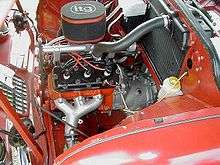Saab two-stroke
The Saab two-stroke was a two-stroke cycle, two cylinder, and later Straight-three engine that Saab based on a DKW design. The first version was 764 cc (46.6 cu in) displacement twin that was transversally mounted in the 1950–1956 Saab 92. It had with 25 hp (19 kW), and a top speed of 100 km/h (62 mph). The 1954 model engine output was raised to 28 hp (21 kW). It had some features only found in modern cars such as one ignition coil per cylinder.


The second type of Saab two stroke engine was a longitudinally placed inline-three cylinder of 748 cc (45.6 cu in) and initially 33 hp (25 kW). It was used in the Saabs 93, 94 (Sonett I, with an engine tuned to 57.5 hp (42.9 kW)), Saab Sonett II, 95, 96, Saab GT750, the Saab Formula Junior and the Saab Quantum. The engine has a belt driven DC dynamo and a coolant water pump.
The 1958-59 Sports version of the 93B had 48–50 hp (36–37 kW) in base version and 57 hp (43 kW) in the super version. This model had triple carburetors and a motor oil injection system, rather than oil pre-mixed with the petrol.
From 1959 displacement was raised to 841 cc (51.3 cu in) with 38 hp (28 kW). For model year 1966, the 'standard' 3-cylinder two-stroke engine had triple carburetors. From model year 1967 Saab began replacing it with the Ford Taunus V4 engine. A special version was built for the United States' 1968 model year, sleeved down to 795 cc (48.5 cu in) to avoid new emission regulations which exempted engines under 50 cu in (819 cc).[1]
Saab also made some experimental V6 engines, by mounting two three cylinder two-stroke engines together, at an angle. One had carburetors on the outside, while another was more conventional, with a carburetor in between the two blocks.
Initially all engines were built at the Saab Trollhättan plant, but engines and gearbox production was 1953[2] moved to an old washing machine factory in Gothenburg[3]. When Saab discontinued production of the two stroke engine and replaced it with a four stroke engine built by Ford in Germany, the plant in Gothenburg never again produced engines, but the production capacity was needed for the increased demand of gearboxes due to the introduction of Saab 99 a few years later.
References
- Flammang, James M. (1994). Standard Catalog of Imported Cars, 1946-1990. Iola, WI: Krause Publications, Inc. p. 559. ISBN 0-87341-158-7.
- "Saab 50 år". Svenska Saabklubben (in Swedish). Retrieved 2020-06-22.
- "Saab's 'little green car' | A classic in sweden's welfare state | Saabs history". history.saab.com. Retrieved 2020-06-22.